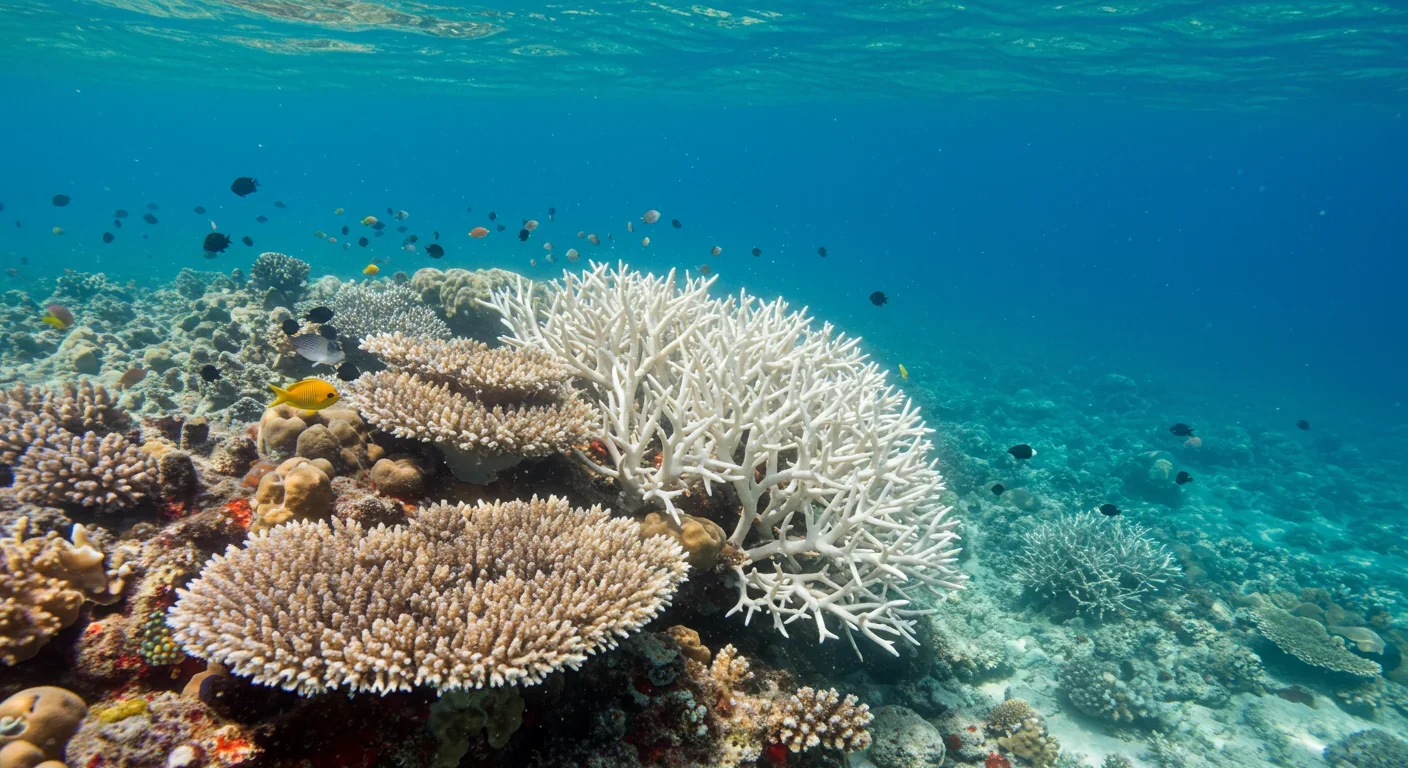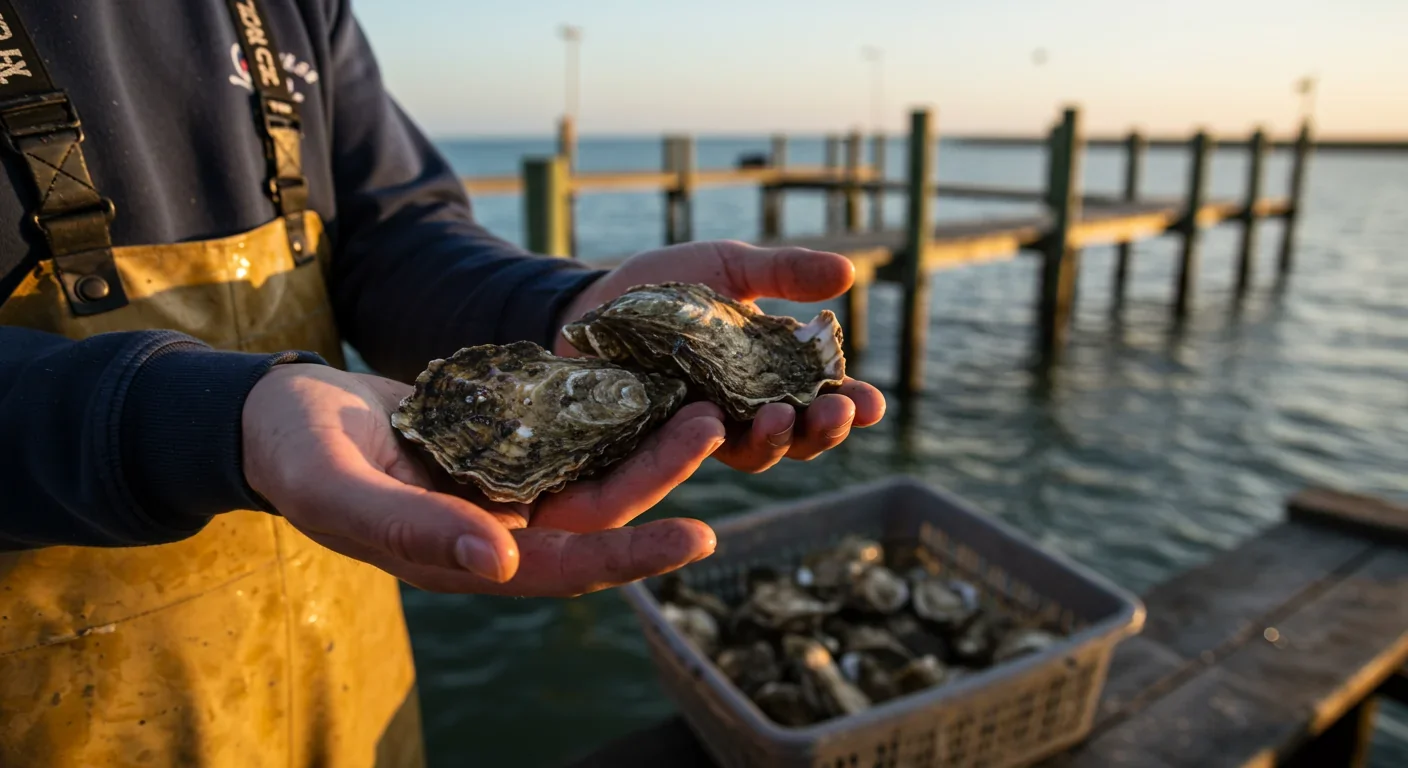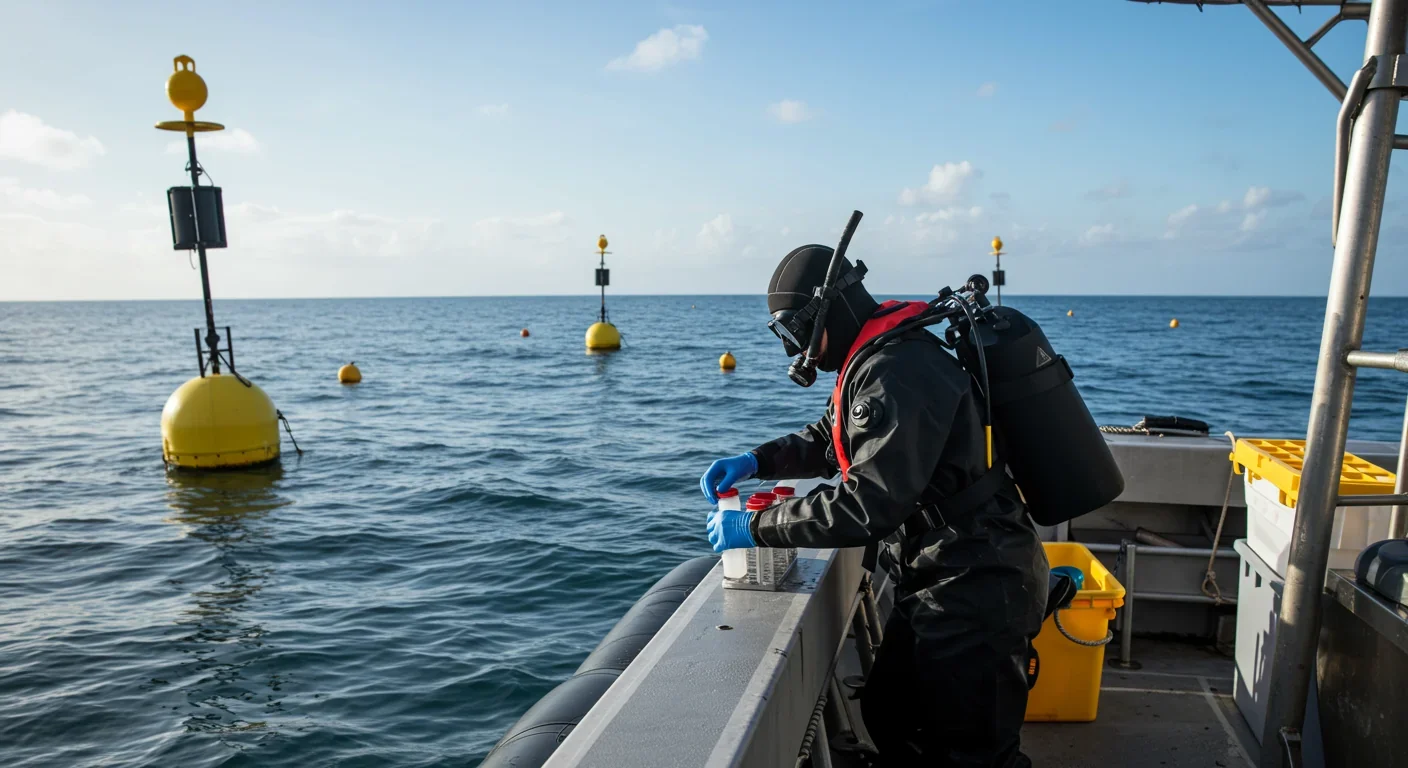Digital Pollution Tax: Can It Save Data Centers?

TL;DR: Ocean acidification has breached a planetary boundary, threatening marine ecosystems from coral reefs to shellfish industries. While CO₂ emissions are the root cause, solutions from emissions cuts to marine protected areas offer hope if we act decisively now.

By 2025, the ocean has absorbed roughly one-third of all the CO₂ humans have pumped into the atmosphere since the Industrial Revolution. That might sound like good news—after all, the seas are doing us a massive favor by buffering climate change. But there's a catch. Every molecule of carbon dioxide that dissolves into seawater triggers a chemical reaction that makes the ocean more acidic. And now, according to the 2025 Planetary Health Check, we've officially crossed a planetary boundary: ocean acidification is no longer a future threat but a present crisis.
While climate scientists have spent decades warning us about rising temperatures, melting ice, and extreme weather, acidification has quietly rewritten the chemistry of the world's oceans. It's the other CO₂ problem, the one that doesn't make headlines but threatens to unravel marine ecosystems from the bottom up.
When CO₂ dissolves in seawater, it doesn't just disappear. It reacts with water molecules to form carbonic acid, which then breaks down into hydrogen ions and bicarbonate. Those extra hydrogen ions are what lower the pH, making the water more acidic. Since the beginning of the Industrial Revolution, the average pH of seawater has dropped from 8.19 to 8.05—a shift that represents a 30% increase in acidity.
That might not sound dramatic. After all, ocean water is still alkaline, not acidic in the way lemon juice is. But pH is measured on a logarithmic scale, which means small numerical changes translate to big chemical shifts. And for marine organisms that build shells and skeletons out of calcium carbonate, those shifts are existential.
Here's why: calcium carbonate formation depends on the availability of carbonate ions in seawater. When hydrogen ions from carbonic acid flood the water, they bind with carbonate ions and turn them into bicarbonate, which organisms can't use. As carbonate ions become scarce, shell-building creatures from clams to coral struggle to construct and maintain their protective structures. Under worst-case scenarios, scientists predict that by 2100, seawater pH could drop to between 7.8 and 7.9, causing carbonate ion concentrations to plummet by at least 50%.
Laboratory experiments bear this out. When researchers lowered the pH of seawater to 7.8, calcifying organisms didn't grow as well as those kept at early 21st-century acidity levels. In some cases, shells became thinner, weaker, more vulnerable to predators and disease.
The impacts ripple outward from individual organisms to entire ecosystems. Coral reefs, often called the rainforests of the sea, are among the most visible casualties. Coral polyps secrete calcium carbonate to build the massive structures that provide habitat for a quarter of all marine species. But acidification chemically breaks down calcium carbonate, forcing corals to divert energy toward simply maintaining their skeletons rather than growing or reproducing.
The result? We're witnessing the fourth global coral bleaching event in recorded history, with shallow reef ecosystems collapsing in regions from the Great Barrier Reef to the Caribbean. These aren't just pretty underwater gardens tourists like to photograph. Coral reefs are spawning grounds for countless fish species, natural breakwaters that protect coastlines from storm surges, and economic engines that generate billions in tourism and fisheries revenue.
Mollusks face similar struggles. Oyster beds along the West Coast of the United States have been in decline since 2005, a trend many marine scientists attribute to the increased stress acidification places on oyster larvae. When baby oysters hatch into a more acidic ocean, they struggle to form their first shells. Many simply don't make it. The same goes for clams, mussels, scallops, and the tiny pteropods—swimming sea snails—that form a crucial link in polar food webs.
But the damage isn't confined to calcifiers. Fish behavior is changing too. Studies suggest that elevated CO₂ levels can impair fish sensory systems, affecting their ability to detect predators, find suitable habitats, and navigate. Some species become bolder and more reckless; others grow lethargic. Either way, the disruption cascades through food webs.
Then there's the phytoplankton problem. These microscopic algae form the foundation of marine food chains and produce roughly half the oxygen we breathe. Rising CO₂ and acidification are expected to reduce phytoplankton populations, which in turn lowers production of dimethyl sulfide (DMS), a compound that seeds cloud formation and helps cool the planet. Models predict DMS production will decline by about 18% by 2100, potentially adding an extra 0.25°C to global temperatures. It's a feedback loop: acidification undermines the very organisms that help regulate climate.

If you're not a marine biologist, you might wonder why any of this matters to you. The answer is simple: 300 million people depend directly on shallow coastal ecosystems for their livelihoods, food security, and protection from storms.
Fisheries are already feeling the pinch. In the Pacific Northwest, oyster hatcheries have reported massive die-offs tied to upwelling events that bring deep, acidic water to the surface. Commercial fishers who depend on shellfish harvests are seeing their catches dwindle and their incomes shrink. Globally, the shellfish industry is worth billions annually, and it's built on organisms that are exquisitely sensitive to pH changes.
Tourism takes a hit too. Coral reefs attract divers and snorkelers from around the world. When reefs bleach and die, so do the businesses that depend on them—dive shops, hotels, restaurants, and entire coastal economies. In places like the Maldives, Fiji, and the Florida Keys, reef degradation threatens not just environmental health but economic survival.
And then there's food security. Roughly three billion people rely on seafood as their primary source of protein. As acidification disrupts fish populations, breeding grounds, and food webs, the availability of that protein source becomes uncertain. Developing nations, particularly small island states, are especially vulnerable. They lack the resources to adapt quickly, and their populations are often most dependent on marine resources.
Why hasn't ocean acidification received the same attention as climate change? Part of the answer is invisibility. You can see a hurricane, feel a heat wave, watch a glacier melt. But pH change is invisible, odorless, tasteless. It doesn't make for dramatic news footage.
Another factor is complexity. Climate change is conceptually straightforward: more greenhouse gases trap more heat. Acidification requires understanding carbonate chemistry, calcification processes, and marine biology. It's harder to explain in a soundbite.
Yet scientists like Johan Rockström, director of the Potsdam Institute for Climate Impact Research, are calling for acidification to be integrated into global climate discussions. The planetary boundaries framework, which quantifies safe operating spaces for human civilization, now lists ocean acidification as one of seven Earth system thresholds we've crossed. Rockström argues that ignoring acidification is like treating a patient's fever while ignoring their pneumonia.
This isn't the first time Earth's oceans have experienced rapid acidification. About 56 million years ago, during the Paleocene-Eocene Thermal Maximum, a massive release of carbon triggered ocean acidification and widespread extinctions of marine life, especially calcifying organisms. The recovery took tens of thousands of years.
The difference today is speed. Natural carbon releases happened over millennia, giving organisms time to adapt or migrate. We're compressing similar changes into a few centuries. Evolutionary timescales can't keep pace with industrial timescales.
But history also offers hope. Past civilizations that degraded their environments—think Easter Island or the Maya—collapsed because they didn't understand the systems they depended on. We do. We have the science, the data, and increasingly, the technology to change course.
The most effective way to halt acidification is obvious: cut CO₂ emissions. Every ton of carbon we don't emit is a ton that won't dissolve into the ocean. This means transitioning to renewable energy, improving energy efficiency, electrifying transportation, and rethinking industrial processes. The Paris Agreement and subsequent climate commitments aim to limit warming to 1.5°C above pre-industrial levels, which would also slow acidification. But current pledges aren't enough. We need faster, deeper cuts.
Beyond emissions reductions, researchers are exploring marine carbon dioxide removal strategies. One approach is ocean alkalinity enhancement, which involves adding alkaline minerals to seawater to neutralize excess acidity and boost carbonate ion concentrations. Think of it as a planetary antacid. Early trials are underway, but scaling up poses logistical, ecological, and regulatory challenges.
Another strategy is protecting and restoring blue carbon ecosystems—mangroves, seagrass beds, and salt marshes—that sequester carbon while also buffering coastal waters from acidification. These habitats absorb CO₂ during photosynthesis and can create localized refuges with higher pH, giving marine life a fighting chance.
Marine protected areas (MPAs) are also critical. By shielding ecosystems from overfishing, pollution, and habitat destruction, MPAs make marine communities more resilient to acidification. A healthy, diverse ecosystem can better withstand pH changes than a stressed, degraded one.
Selective breeding and assisted evolution offer another frontier. Scientists are identifying coral and shellfish strains that tolerate lower pH and experimenting with breeding programs to enhance resilience. It's not a silver bullet, but it could buy time for vulnerable species.

Ocean acidification is increasingly appearing in international agreements. The United Nations Sustainable Development Goal 14 explicitly calls for minimizing and addressing ocean acidification. The Paris Agreement indirectly tackles it by targeting emissions reductions. And there are growing calls to incorporate the planetary boundaries framework into COP negotiations, making acidification an explicit focus alongside warming and biodiversity loss.
Regional efforts are gaining traction too. The West Coast Ocean Acidification and Hypoxia Science Panel in the United States has coordinated research and monitoring since 2013. European nations are investing in acidification research through Horizon Europe. Small island developing states are advocating loudly for action, recognizing that their survival depends on healthy oceans.
But progress is slow. Unlike ozone depletion, which had a clear villain (CFCs) and a straightforward fix (phase them out), acidification is tied to the entire fossil fuel economy. Solving it requires systemic transformation.
Individual actions matter, especially when they scale. Reducing your carbon footprint directly reduces the CO₂ that ends up in the ocean. Drive less, fly less, insulate your home, choose renewable energy, eat less meat. These aren't new suggestions, but their urgency grows as boundaries are breached.
Support policies and politicians that prioritize climate action. Vote, write letters, attend town halls, join advocacy groups. Systemic change requires political will, and political will requires public pressure.
Choose sustainable seafood. Apps like Seafood Watch help consumers avoid overfished species and support fisheries that manage resources responsibly. Reducing stress on marine ecosystems makes them more resilient to acidification.
Reduce plastic use and pollution. While acidification is primarily a CO₂ problem, marine ecosystems face multiple stressors. Lowering pollution levels gives organisms a better chance to cope with pH changes.
Educate others. Share what you've learned. Ocean acidification is underreported and poorly understood. Conversations at dinner tables, social media posts, school presentations—all of these help shift public awareness.
Support research and conservation organizations working on ocean health. Groups like the Ocean Acidification Alliance, Coral Restoration Foundation, and Project Drawdown are developing solutions and advocating for policy change. Your donations and volunteer time amplify their impact.
If you live near the coast, participate in citizen science programs. Many research institutions welcome volunteers to help monitor water chemistry, track species populations, and collect data. Your observations contribute to the scientific understanding that drives action.
The ocean acidification boundary has been breached, but it hasn't been obliterated. The difference matters. If we act swiftly and decisively, we can stabilize pH levels before the most catastrophic tipping points are reached. If we delay, we risk triggering cascading collapses in marine ecosystems that will take millennia to recover—if they recover at all.
The choice is ours, and the window is closing. Ocean acidification is a test of whether we can think long-term, act collectively, and value systems we can't always see. So far, we're failing that test. But the exam isn't over yet.
Every ton of CO₂ we prevent from entering the atmosphere is a ton that won't acidify the ocean. Every marine ecosystem we protect is a reservoir of resilience. Every policy we pass is a step toward a healthier planet. The solutions exist. What we need now is the will to implement them—before the chemistry of our oceans shifts beyond recognition, taking the life they support with them.

Recent breakthroughs in fusion technology—including 351,000-gauss magnetic fields, AI-driven plasma diagnostics, and net energy gain at the National Ignition Facility—are transforming fusion propulsion from science fiction to engineering frontier. Scientists now have a realistic pathway to accelerate spacecraft to 10% of light speed, enabling a 43-year journey to Alpha Centauri. While challenges remain in miniaturization, neutron management, and sustained operation, the physics barriers have ...

Epigenetic clocks measure DNA methylation patterns to calculate biological age, which predicts disease risk up to 30 years before symptoms appear. Landmark studies show that accelerated epigenetic aging forecasts cardiovascular disease, diabetes, and neurodegeneration with remarkable accuracy. Lifestyle interventions—Mediterranean diet, structured exercise, quality sleep, stress management—can measurably reverse biological aging, reducing epigenetic age by 1-2 years within months. Commercial ...

Data centers consumed 415 terawatt-hours of electricity in 2024 and will nearly double that by 2030, driven by AI's insatiable energy appetite. Despite tech giants' renewable pledges, actual emissions are up to 662% higher than reported due to accounting loopholes. A digital pollution tax—similar to Europe's carbon border tariff—could finally force the industry to invest in efficiency technologies like liquid cooling, waste heat recovery, and time-matched renewable power, transforming volunta...

Humans are hardwired to see invisible agents—gods, ghosts, conspiracies—thanks to the Hyperactive Agency Detection Device (HADD), an evolutionary survival mechanism that favored false alarms over fatal misses. This cognitive bias, rooted in brain regions like the temporoparietal junction and medial prefrontal cortex, generates religious beliefs, animistic worldviews, and conspiracy theories across all cultures. Understanding HADD doesn't eliminate belief, but it helps us recognize when our pa...

The bombardier beetle has perfected a chemical defense system that human engineers are still trying to replicate: a two-chamber micro-combustion engine that mixes hydroquinone and hydrogen peroxide to create explosive 100°C sprays at up to 500 pulses per second, aimed with 270-degree precision. This tiny insect's biochemical marvel is inspiring revolutionary technologies in aerospace propulsion, pharmaceutical delivery, and fire suppression. By 2030, beetle-inspired systems could position sat...

The U.S. faces a catastrophic care worker shortage driven by poverty-level wages, overwhelming burnout, and systemic undervaluation. With 99% of nursing homes hiring and 9.7 million openings projected by 2034, the crisis threatens patient safety, family stability, and economic productivity. Evidence-based solutions—wage reforms, streamlined training, technology integration, and policy enforcement—exist and work, but require sustained political will and cultural recognition that caregiving is ...

Every major AI model was trained on copyrighted text scraped without permission, triggering billion-dollar lawsuits and forcing a reckoning between innovation and creator rights. The future depends on finding balance between transformative AI development and fair compensation for the people whose work fuels it.